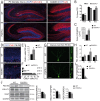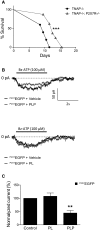Neurodevelopmental alterations and seizures developed by mouse model of infantile hypophosphatasia are associated with purinergic signalling deregulation
- PMID: 27466191
- PMCID: PMC5291194
- DOI: 10.1093/hmg/ddw248
Neurodevelopmental alterations and seizures developed by mouse model of infantile hypophosphatasia are associated with purinergic signalling deregulation
Abstract
Hypomorphic mutations in the gene encoding the tissue-nonspecific alkaline phosphatase (TNAP) enzyme, ALPL in human or Akp2 in mice, cause hypophosphatasia (HPP), an inherited metabolic bone disease also characterized by spontaneous seizures. Initially, these seizures were attributed to the impairment of GABAergic neurotransmission caused by altered vitamin B6 (vit-B6) metabolism. However, clinical cases in human newborns and adults whose convulsions are refractory to pro-GABAergic drugs but controlled by the vit-B6 administration, suggest that other factors are involved. Here, to evaluate whether neurodevelopmental alterations are underlying the seizures associated to HPP, we performed morphological and functional characterization of postnatal homozygous TNAP null mice, a model of HPP. These analyses revealed that TNAP deficient mice present an increased proliferation of neural precursors, an altered neuronal morphology, and an augmented neuronal activity. We found that these alterations were associated with a partial downregulation of the purinergic P2X7 receptor (P2X7R). Even though deficient P2X7R mice present similar neurodevelopmental alterations, they do not develop neonatal seizures. Accordingly, we found that the additional blockage of P2X7R prevent convulsions and extend the lifespan of mice lacking TNAP. In agreement with these findings, we also found that exogenous administration of ATP or TNAP antagonists induced seizures in adult wild-type mice by activating P2X7R. Finally, our results also indicate that the anticonvulsive effects attributed to vit-B6 may be due to its capacity to block P2X7R. Altogether, these findings suggest that the purinergic signalling regulates the neurodevelopmental alteration and the neonatal seizures associated to HPP.
© The Author 2016. Published by Oxford University Press.
Figures






Similar articles
-
Haploinsufficient TNAP Mice Display Decreased Extracellular ATP Levels and Expression of Pannexin-1 Channels.Front Pharmacol. 2018 Mar 2;9:170. doi: 10.3389/fphar.2018.00170. eCollection 2018. Front Pharmacol. 2018. PMID: 29551976 Free PMC article.
-
Enzyme replacement for craniofacial skeletal defects and craniosynostosis in murine hypophosphatasia.Bone. 2015 Sep;78:203-11. doi: 10.1016/j.bone.2015.05.005. Epub 2015 May 8. Bone. 2015. PMID: 25959417 Free PMC article.
-
Identification of altered brain metabolites associated with TNAP activity in a mouse model of hypophosphatasia using untargeted NMR-based metabolomics analysis.J Neurochem. 2017 Mar;140(6):919-940. doi: 10.1111/jnc.13950. J Neurochem. 2017. PMID: 28072448 Free PMC article.
-
Tissue-Nonspecific Alkaline Phosphatase-A Gatekeeper of Physiological Conditions in Health and a Modulator of Biological Environments in Disease.Biomolecules. 2020 Dec 8;10(12):1648. doi: 10.3390/biom10121648. Biomolecules. 2020. PMID: 33302551 Free PMC article. Review.
-
Multisystemic functions of alkaline phosphatases.Methods Mol Biol. 2013;1053:27-51. doi: 10.1007/978-1-62703-562-0_3. Methods Mol Biol. 2013. PMID: 23860646 Review.
Cited by
-
The Metabotropic Purinergic P2Y Receptor Family as Novel Drug Target in Epilepsy.Front Pharmacol. 2018 Mar 7;9:193. doi: 10.3389/fphar.2018.00193. eCollection 2018. Front Pharmacol. 2018. PMID: 29563872 Free PMC article. Review.
-
TNAP and P2X7R: New Plasma Biomarkers for Alzheimer's Disease.Int J Mol Sci. 2023 Jun 30;24(13):10897. doi: 10.3390/ijms241310897. Int J Mol Sci. 2023. PMID: 37446074 Free PMC article.
-
Targeting Neuroinflammation via Purinergic P2 Receptors for Disease Modification in Drug-Refractory Epilepsy.J Inflamm Res. 2021 Jul 18;14:3367-3392. doi: 10.2147/JIR.S287740. eCollection 2021. J Inflamm Res. 2021. PMID: 34305404 Free PMC article. Review.
-
Purinergic Signalling: Therapeutic Developments.Front Pharmacol. 2017 Sep 25;8:661. doi: 10.3389/fphar.2017.00661. eCollection 2017. Front Pharmacol. 2017. PMID: 28993732 Free PMC article. Review.
-
Diagnosis and Treatment of Hypophosphatasia.Calcif Tissue Int. 2025 Mar 6;116(1):46. doi: 10.1007/s00223-025-01356-y. Calcif Tissue Int. 2025. PMID: 40047955 Free PMC article. Review.
References
-
- Narisawa S., Hasegawa H., Watanabe K., Millan J.L. (1994) Stage-specific expression of alkaline phosphatase during neural development in the mouse. Dev. Dyn., 201, 227–235. - PubMed
-
- Whyte M.P., Zhang F., Wenkert D., McAlister W.H., Mack K.E., Benigno M.C., Coburn S.P., Wagy S., Griffin D.M., Ericson K.L., et al. (2015) Hypophosphatasia: validation and expansion of the clinical nosology for children from 25 years experience with 173 pediatric patients. Bone, 75, 229–239. - PubMed
-
- Narisawa S., Frohlander N., Millan J.L. (1997) Inactivation of two mouse alkaline phosphatase genes and establishment of a model of infantile hypophosphatasia. Dev. Dyn., 208, 432–446. - PubMed
-
- Narisawa S., Wennberg C., Millan J.L. (2001) Abnormal vitamin B6 metabolism in alkaline phosphatase knock-out mice causes multiple abnormalities, but not the impaired bone mineralization. J. Pathol., 193, 125–133. - PubMed
MeSH terms
Substances
Supplementary concepts
Grants and funding
LinkOut - more resources
Full Text Sources
Other Literature Sources
Medical
Molecular Biology Databases
Miscellaneous

